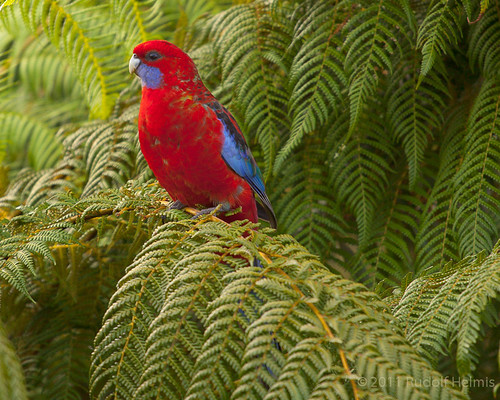 Crimson Rosella (Platycercus elegans) Australia. Photo: Rudolfhelmis
Crimson Rosella (Platycercus elegans) Australia. Photo: Rudolfhelmis
New research has uncovered how different crimson rosella populations are related to each other – a discovery which has important implications for research into how climate change may affect Australia’s biodiversity.
Published today in the prestigious journal Proceedings of the Royal Society B, the research investigates the genetic and geographical relationships between different forms of crimson rosellas and the possible ways that these forms may have arisen.
 Figure 1. (a) Distribution and plumage phenotype variation in parrots of the Crimson Rosella complex in eastern Australia (from Forshaw & Cooper (2002) in this and subsequent figures). Note the narrow zone of unsuitable habitat currently separating Adelaide and Yellow. (b, c) Sampling scheme of vouchered museum specimens for mtDNA analyses of the full mainland distribution of the complex.
Figure 1. (a) Distribution and plumage phenotype variation in parrots of the Crimson Rosella complex in eastern Australia (from Forshaw & Cooper (2002) in this and subsequent figures). Note the narrow zone of unsuitable habitat currently separating Adelaide and Yellow. (b, c) Sampling scheme of vouchered museum specimens for mtDNA analyses of the full mainland distribution of the complex.
Dr Gaynor Dolman of CSIRO’s Australian National Wildlife Collection says there are three main colour ‘forms’ of the crimson rosella – crimson, yellow and orange – which originated from the same ancestral population and are now distributed throughout south eastern Australia.
“Many evolutionary biologists have argued that the different forms of crimson rosellas arose, or speciated, through ‘ring speciation’,” she says.
The ring speciation hypothesis predicts that a species that spreads to new areas may eventually join back up with itself, forming a ring. By that time, the populations at the join in the ring may be two distinct species and unable to interbreed, despite continuous gene flow, or interbreeding, between populations around the ring.
 Figure 2. Unrooted network of mtDNA diversity in southeastern Australian populations of the Crimson Rosella complex, showing groups (a) 1, (b) 2 and (c) 3 as referred to in the text. Open circles indicate unsampled haplotypes. Colours in circles indicate the plumage phenotype of samples as in figure 1. The sample size for each haplotype is 1, unless otherwise indicated with a number. KI refers to haplotypes found in eight Kangaroo Island Crimson individuals. A solid line with open circles shows where the North Queensland populations join the network. A unimodal mismatch plot for (c) is shown in (d). (d) Dotted line, observation; solid line, expected
Figure 2. Unrooted network of mtDNA diversity in southeastern Australian populations of the Crimson Rosella complex, showing groups (a) 1, (b) 2 and (c) 3 as referred to in the text. Open circles indicate unsampled haplotypes. Colours in circles indicate the plumage phenotype of samples as in figure 1. The sample size for each haplotype is 1, unless otherwise indicated with a number. KI refers to haplotypes found in eight Kangaroo Island Crimson individuals. A solid line with open circles shows where the North Queensland populations join the network. A unimodal mismatch plot for (c) is shown in (d). (d) Dotted line, observation; solid line, expected
“We found that in the case of crimson rosellas, their three separate genetic groups don’t show a simple link to the geographical distribution of the colour forms,” Dr Dolman says.
“For example, orange Adelaide and crimson Kangaroo Island rosellas are separated by 15km of ocean but are genetically similar. Conversely, genetic dissimilarity was found in the geographically linked yellow and orange populations in inland south eastern Australia.
“We rejected the ring hypothesis because it predicts only one region of genetic dissimilarity, which should occur at the geographical location of the join in the ring, around the headwaters of the Murray and Murrumbidgee Rivers.
 Figure 3. (a) Summary of microsatellite analyses of southeastern Australian populations of the Crimson Rosella complex. Coloured squares are microsatellite-based GENELAND classifications of individuals as described in the text (EasternGL, CentralGL and WesternGL). Bicoloured symbols show the three individuals that were classified as 'hybrid' assignments of 0.61 EasternGL/0.38 CentralGL, 0.05 EasternGL/0.95 CentralGL and 0.16 EasternGL/0.84 WesternGL. (b) The map details sampling for microsatellites in the upper and middle reaches of the Murray River system and shows discordance between microsatellitebased assignments (squares) and plumage phenotypes (circles).
Figure 3. (a) Summary of microsatellite analyses of southeastern Australian populations of the Crimson Rosella complex. Coloured squares are microsatellite-based GENELAND classifications of individuals as described in the text (EasternGL, CentralGL and WesternGL). Bicoloured symbols show the three individuals that were classified as 'hybrid' assignments of 0.61 EasternGL/0.38 CentralGL, 0.05 EasternGL/0.95 CentralGL and 0.16 EasternGL/0.84 WesternGL. (b) The map details sampling for microsatellites in the upper and middle reaches of the Murray River system and shows discordance between microsatellitebased assignments (squares) and plumage phenotypes (circles).
“However, it is possible that crimson rosellas formed a ring at some stage in their evolutionary history, but that the evidence has been lost through climatic or environmental changes,” she says.
Wildlife genetic research of this kind is increasing our understanding of the biogeography and evolution of Australia’s terrestrial vertebrates, helping Australia sustainably manage its biodiversity and ecosystem functions in the face of land use and climate change.
This work involved a team of researchers from CSIRO, Deakin University and the South Australian Museum.